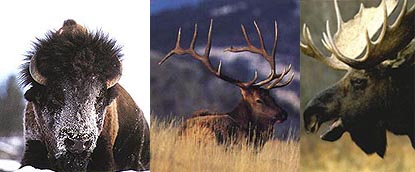|
DIMENSIONS: ecosystem |
Wolf BiologyPredator and prey responses to wolf reintroduction
Wolf Biology The "gray wolf" actually occurs in several colors, and the pelage of most wolves contains several shades of different colors. Gray wolves range from creamy white all the way to inky black. Pups from a single litter often show color variety, and wolf packs include animals of all different colors. A lot like fish, wolves are dark above and light below. A typical gray wolf has cream or white legs and tan sides. The long black guard hairs on the back and shoulders give wolves dark backs. The complex light and dark shading on a wolf's face dramatizes its expressions, which is useful for such highly social animals Gray wolves are smaller than most people think. Most weigh between 50 and 100 pounds, females about 20% smaller than males. Size is related to geography. The wolves of some desert regions may not exceed 45 pounds, and the Mexican wolf is small enough to be mistaken for a coyote. However, weights of 115 pounds are not uncommon for cold regions. The largest wolves come from Alaska, the Yukon, some areas of Canada, and the former Soviet Union. Those regions occasionally produce individuals weighing up to 175 pounds. The length of a gray wolf are approximate to the height of humans; they vary between five and six and a half feet long (nose to tail tip). Of that length, about 18 inches is tail. Males usually stand 26 to 32 inches at the shoulder females about 20% less. The teeth of a wolf are its livelihood. There are 42 teeth which all serve a particular function. The four canines, for which wolves are known, are usually over an inch long. Their primary purpose is to pierce the hide and hair of various ungulates and the like. This provides a sure hold as well when attempting to take down a large prey species. The molars at the back of the jaw have the power to crush even femoral bones. Between the molars and the canines are the carnassial teeth, which shear skin, sinew and muscle. If the teeth of the wolf is its livelihood then the senses of the wolf are its bread and butter. Vision primarily becomes important to wolves during chases when prey is near. Wolves can apparently detect moving objects at distances where they cannot discern stationary objects. A wolf's sense of hearing is far more acute than that of a human. A wolf's concave external ear funnels sound vibrations to the inner ear and can hear howling as far as six miles away, possibly up to ten. They can also discriminate between tones that are very similar. Most biologists claim that wolves are a hundred times better at sensing odors than humans, some even say much more so than a hundred. Wolves can smell prey up to a mile and a half away in a favorable wind. Of course there are odors wolves can detect which we can't measure due to the fact we have no way of knowing they are present, this is the crux of the wolf. Click here to find out more about wolf biology and taxonomy.
Predator and prey responses to wolf reintroduction
One of the major influences of re-introducing a large predator on an ecosystem is the response of that predators prey as well as other predators in the area. We will cover the primary prey of wolves (Elk) and the primary competitive predator (coyote). There are other predator and prey which are affected as well which will also be covered. Predators
Coyote- He used to be top dog, but no more... Black bear- Do wolves have an adverse affect on his omnivorous ways? Grizzly bear- Is the "king" of Yellowstone still the apex predator? Mountain lion- Does this elusive cat interact with wolves?
Prey
Elk- Will wolves "wipe-out" the elk in Yellowstone? Bison- How often do wolves actually hunt bison? Mule deer- Are there enough to survive a high wolf population? Moose- Not to many in Yellowstone, how will they fare? Bighorn sheep- Not a traditional prey species of wolves, will they be affected at all? Pronghorn antelope - Can the wolves even catch one? White-tail deer / Mountain goats- Some believe these species won't experience any loss to wolves
Prey related to human habitation Cows- Are the predation numbers as high as everyone feared? Sheep- Is this a traditional prey species of wolves? Domesticated dogs- Not a prey species, but how have they been affected by the reintroduction? Other possible prey species in the Greater Yellowstone Ecosystem To see trophic effects of wolves on ecosystems click here CoyotesThe GYE coyotes seem to be the most affected by the reintroduction of gray wolves. Prior to the reintroduction in 1995 coyotes displayed a pack structure of their own when they existed at, or close to carrying capacity. Coyotes were the number one predator of elk calves, taking more than even mountain lions, black bears and grizzly bears. This all changed when the wolves showed up in 1995. When the first pack of wolves, the rose creek pack, was introduced into their pens for acclimitization researchers and observers noted many coyotes howling for over a half an hour. It seems the coyote had an idea of what this apex predator meant for them. In the five years since the reintroduction of the wolves researchers have noted many changes in coyote life. The most significant is the decrease of coyote numbers. In the last five years coyote populations have decreased somewhere between 30-50%. For the first four years wolves would simply kill coyotes and leave the carcass, but in 1999 researchers observed the Druid peak pack kill a number of coyote pups and bring them back to the den to feed their own pups. This all has affected coyote behavior in many ways. It is now observed that coyotes den very close to human settlements within the park, so as to stay away from the core wolf territories. Another interesting response that has been observed within the last year is a fundamental breakdown of the pack structure they once showed five years ago. There have been multiple litters within loose packs (no alpha male and female) and the "helpers" within the pack no longer help, but are observed to be hunting and foraging more on their own. These could all be mechanisms to combat increased mortality or it could be because food supply has increased with the number of carcasses left by wolves. Either way studies are currently being done to get a better understanding of the coyotes place now within the GYE. Black bearsNot a lot of information is currently known about black bear/ wolf interactions. Most observations have been of wolves chasing black bears off of kill sites. But when dealing with large predators this can also be a numbers game. A solitary bear can displace a solitary wolf off of a kill site. Grizzly bearsTher has not been a documented case of wolves killing a mature grizzly as well as vice versa. But there have been multiple observations of grizzlies displacing wolves from kill sites as well as approaches to wolf den sites. Mountain lionsThe biggest influence on cougars is determined by a significant dietary and spatial overlap. This is determined three ways. First, alter population characteristics such as age ratios. Second is animal behavior and third is the distribution of prey. There have been no observable interactions of wolves and cougars but research continues. Yellowstone elkElk currently constitute roughly 85% of the GYE wolves diet. The 12+ packs that exist within the GYE take an approximated 130 elk per year. This has not affected elk populations significantly, the biggest affect has been the recruitment of younger elk, but otherwise the elk population has seen an overall decrease of 8-20% relative to the year populations are counted and accounting for winter and summer ranges. Yellowstone bisonThere are no direct predation numbers known of bison but researchers do know that wolves have been "learning" to kill bison and have been successfully hunting them since the winter of 1997, when they took two bison. Yellowstone MooseDuring the winter of 1997 moose consisted of 11% of the GYE wolves diet. Researchers believed this was a higher amount of predation than to be expected on a regular basis. Moose will most likely make up 5-11% of the annual diet of the GYE wolves. There should be no population affect. Yellowstone Bighorn sheepAs to date there has been no predation of bighorn sheep by wolves. It is even possible that bighorn sheep populations might be increasing due to the fact that they are able to occupy areas once overrun by elk. Yellowstone Pronghorn AntelopeThe pronghorn is expected to see the same effect as that of the bighorn. A relative increase in population due to the fact that they are fairly unavailable to wolves and would therefore occupy territories once occupied by large numbers of elk.
Yellowstone White-tail deer/Mountain goatsThese two species are generally regarded as a scavenging option for wolves in the GYE and probably will not be affected (as they haven’t been so far) by the reintroduction. This is due to their low numbers and the geographical niches they occupy.
Domestic cowsBetween the years of 1995-1999 wolves within the GYE had taken thirteen cattle.
Domestic sheepThese numbers are fairly inconsistent but the last accurate count in 1998 was fifty-five sheep lost to wolves within the GYE. Domestic dogsDomestic dogs are likely killed because of territory disputes. The dog will defend his or her "master’s" territory much the same a pack will defend their territory. There have been six confirmed losses to wolves over the past five years.
Suspected other prey species (known or suspected in Greater Yellowstone Ecosystem) -Long-tailed vole -Yellow-pine chipmunk -Meadow vole -Uinta chipmunk -Montane vole -Northern pocket gopher -Uinta ground squirrel -Golden-mantled ground squirrel -Mountain cottontail -Snowshoe hare -Yellow-bellied marmot -Whitetailed jack-rabbit -Porcupine -Beaver
Yellowstone pack morphology Currently there are 118+ wolves located within the Greater Yellowstone Ecosystem. They are formed into an approximate 12+ packs that are very fluid in structure. For a complete and updated synopsis of pack morphology, pup counts, mortality counts, and dispersing individuals numbers click here. For updated observations and pack movements click here.
|







